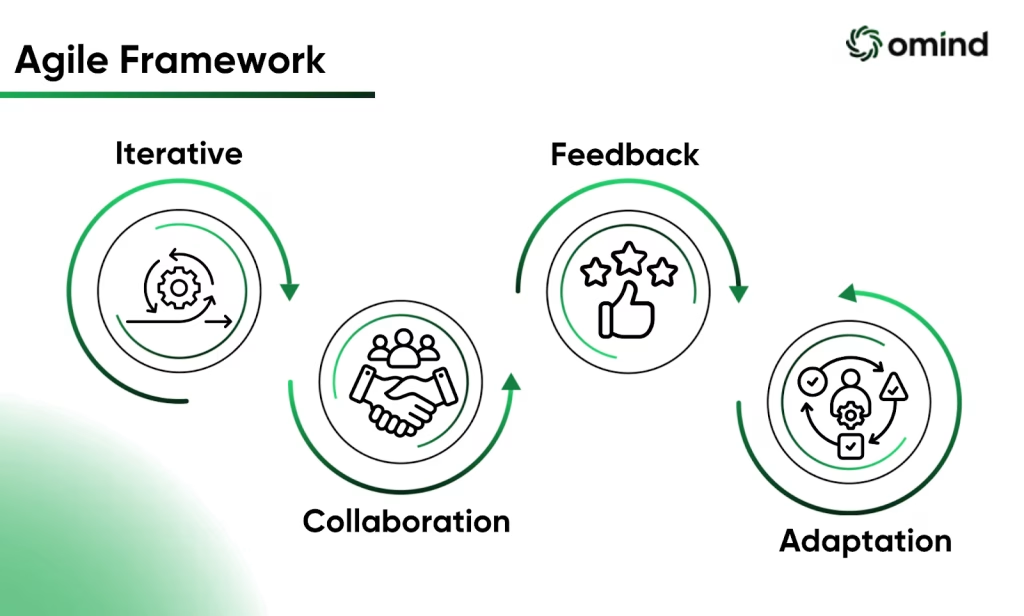What comes to your mind when thinking about the word agile? Quick management, services, development, and more. So, how does this help the customer experience? Agile means more than quickness; it’s about making customers happy and loyal. Today, businesses realize that a one-size-fits-all approach to customer experience (CX) is insufficient. Enter Agile Customer Experience (CX) – a dynamic customer-centric method revolutionizing how businesses interact with customers.
Agile CX isn’t just a term; it’s a method that empowers organizations to respond to evolving customer requirements swiftly. Picture a quick athlete effortlessly navigating through obstacles – that’s the essence of Agile CX. It’s all about being adaptable, responsive, and flexibly focused on delivering value to the customer.
This method is necessary because customers need faster and more reliable methods to solve their issues. When a business fails to adapt, it lags behind others. So, as a businessperson, you must expect customer needs and deliver exceptional experiences that keep them coming back for more.
Now that we’ve seen the big picture, let’s explore how planning plays a crucial role in bringing Agile CX to life.”
The Value of Agile CX Strategy
The customer experience (CX) is what makes you different from others. Companies understand that offering outstanding customer experience will determine their success in the market.

- The time customers return only for your product quality is long gone. Today’s customers are in the middle of diverse options. So, resolving problems, personalization, or website navigation all affect how a client views a company.
- That’s when the Agile CX strategy becomes more relevant. Agile approaches allow companies to quickly improve their offers. They also help companies remain aware of changing customer wants and preferences, which helps them keep clients.
- Their organizations adopt Agile customer experience methods with the initiatives of CEOs and organizational leaders. From the top down, they established the value of customer-centricity and allowed teams to rank CX projects.
- Business owners are investing in CX to protect their companies’ long-term survival. Agile CX approaches allow businesses to create an innovative, responsive, and continually improving culture. Enterprises are now doing everything they can to promote Agile CX practices in their firms.
- Understanding and implementing the right Agile CX strategy can be challenging. Omind’s platform can simplify this process, providing the tools and insights necessary to tailor your approach to CX. Try it out to discover how our platform can enhance your strategy.
But it’s not just about strategies and plans; at its heart, it’s about putting the customer first. Let’s see how.
Adopting a Customer-Centric Approach
Today, customers hold more power and influence than ever before. Businesses emphasizing consumers are better positioned to build loyalty in a competitive market.
One of the essential bases of a customer-centric approach is the active involvement of customers at every touchpoint. Gone are the days of making assumptions about what customers want. Now, it’s all about obtaining real-time feedback and insights from the source. By seeking input through surveys, interviews, and social media platforms, firms can get significant insights into the pain points. This real-time feedback process helps organizations fix issues and provide experiences that customers expect.
Firms must match their goals, plans, and projects with their customers’ requirements to adopt a customer-centric strategy. This approach promotes collaboration across departments and builds teams that drive CX excellence. By bringing together people from all departments, firms can get a holistic picture of the customer journey and find possibilities for improvement. Dedicated CX teams can do wonders to increase sales and improve the customer experience.
Adopting a customer-centric approach requires deep insights into customer behavior and preferences. Omind offers advanced generative AI capabilities to gather these insights effectively, laying the groundwork for a successful Agile CX strategy. See how our solution can transform your approach.
With the customer at the center of our compass, let’s explore the guiding principles that steer the agile CX ship.
Principles of Agile in CX Strategy

Adopting agile principles can be transformative in customer experience (CX) planning. By prioritizing flexibility, businesses can build experiences that connect with their audience, driving loyalty and satisfaction.
Prioritizing Relationships: In Agile customer experience, strategy is not the only way to concentrate the speed; it is more than that. Rather than viewing customers as mere transactions, organizations make meaningful connections that promote long-term engagement. Businesses can nurture customer trust and loyalty by investing in personalized interactions and open communication.
Adopting Flexibility: This method embraces flexibility and avoids rigid policies. The company understands that every customer is unique and builds a team to solve their problems. This flexible method enhances business and enables organizations to resolve issues, improving satisfaction.
Great. We’ve covered the what and the why, but how about the how? Let’s get down to the nitty-gritty of making Agile CX work day to day.
Operationalizing Agile CX
Implementing agile methodologies is the key to staying ahead and delivering exceptional experiences that drive customer satisfaction and loyalty.
Continuous Improvement
Continuous improvement as per the change is vital for Agile CX. It involves gathering feedback, analyzing data, and making quick changes. By listening to customer feedback and identifying pain points, you can ensure that their CX efforts remain valuable.
Empowering Teams
To proceed with Agile CX, businesses must empower their teams with the right tools, data, and analytical skills. By providing robust data and investing in training, companies can allow their teams to make informed decisions. These decisions drive customer satisfaction. Empowered teams understand the needs, experiment with new ideas, and drive meaningful change across the company.
We’ve tackled the operational side; now, let’s zoom out and gaze into the crystal ball to see what the future holds for Agile CX.
Agile will Rule the Future of Customer Experience

Adopting agility is vital for the future of customer experience (CX). By prioritizing creativity, companies may remain ahead of the curve and satisfy their customers.
Adaptability in CX is vital in a setting that is evolving quickly. Organizations can quickly adjust and predict what’s coming. Businesses that value agility can better adapt and prosper in the face of uncertainty. Whether it comes from changing consumer tastes or developing technology, the future is unavoidable.
Customer experience (CX) innovation is the way of the future, and agility is the key to opening up new doors of expansion. Organizations may refine their offers, try new concepts, and provide experiences that keep customers happy. Agile firms are set to lead in defining the future of customer experience. They’ll do this by reinventing touchpoints or personalizing interactions.
Sounds promising, right? Let’s back it up with some real-world impact—here are a few case studies where Agile CX truly shines.
Case Studies and Examples:
Examining successful Agile CX transformations across various industries provides invaluable insights into the effect on customer satisfaction.
1. Retail Industry: A leading retailer adopted Agile customer experience strategies by prioritizing quick adjustments based on real-time customer feedback. They embraced flexible approaches, such as in pricing and promotions. This led to a significant rise in customer satisfaction and a sales boost.
2. Telecommunications Sector: A telecommunications company filters its customer service processes using agile methodologies. By empowering frontline workers and refining processes based on customer feedback, they reduced customer loss and increased customer loyalty.
Inspired by these successes in Agile CX transformations? Omind’s experience management platform has been at the heart of many such changes. It offers the agility, insights, and support businesses need to do well. Learn from our experts and take your customer experience to the next level.
With these examples lighting the way, let’s wrap up with some final thoughts on the transformative power of Agile CX.
A Final Thought
In the coming years, the expectations of customers continue to evolve. So, companies must review their method of dealing with customers with new methods. Agile CX is a long-term strategy for businesses. It helps them stay competitive and thrive in today’s fast-changing marketplace. Organizations can position themselves as leaders in their field by prioritizing customer satisfaction and embracing agility.
Agile CX puts the customer at the forefront of every choice and action. With innovation, you can build stronger relationships, drive loyalty, and differentiate yourself in a crowded market. Adopting agile customer experience isn’t a one-time effort; it’s a continuous journey of evolution and improvement. It needs a fundamental shift in customer-centricity and a commitment to ongoing learning and adaptation. By getting support from providers like Omind, businesses can move to innovation and continuous improvement that drives success. Want to implement Agile CX? Schedule a demo with us now.


